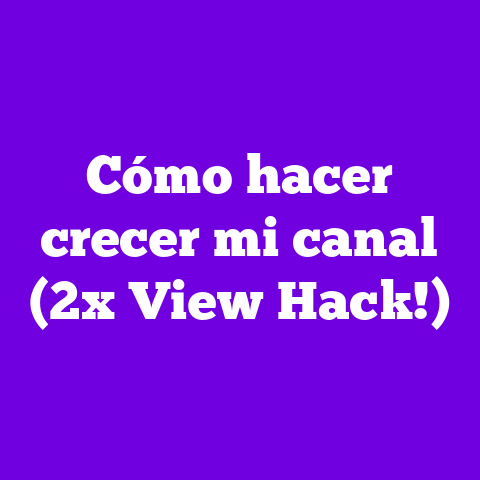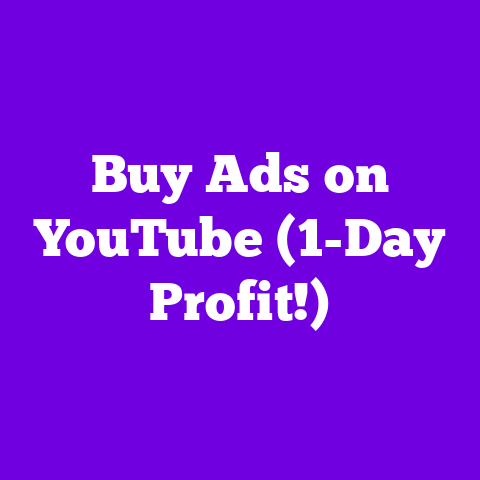AI & the Future of US YouTube (5 Shocking Cracks!)
YouTube.
It’s a digital playground, a source of income, and for many, a passion project.
But what happens when the game changes?
What happens when artificial intelligence (AI) starts calling the shots?
Imagine Alex.
Five years ago, Alex started a YouTube channel dedicated to sustainable living.
Through engaging tutorials, insightful vlogs, and a genuine connection with their audience, Alex built a thriving community.
They quit their 9-to-5, bought a solar-powered van, and were living the dream.
Fast forward to 2025.
YouTube is a different beast.
AI-generated content is exploding, algorithms are more complex than ever, and monetization strategies are shifting beneath Alex’s feet.
The very foundation of their success is starting to crack.
I’ve been watching these trends closely, and I’m here to tell you, the cracks are real.
They’re happening now, and they’re going to reshape the future of YouTube.
Today, we’re diving deep into five shocking changes that will impact every US YouTube creator by 2025.
Are you ready to face the future?
Section 1: The Rise of AI-Generated Content
Let’s face it, AI is no longer some futuristic fantasy.
It’s here, it’s powerful, and it’s generating content.
We’re not just talking about simple video editing tools.
We’re talking about AI that can write scripts, create visuals, and even generate entire videos from scratch.
Think about it.
AI tools like Synthesia and Pictory are already allowing users to create professional-looking videos without ever showing their face or even recording their voice.
Imagine the possibilities!
Now, scale that up.
By 2025, expect AI to be capable of producing highly engaging, personalized content at scale.
What does this mean for creators like Alex?
Well, it means competition is about to get a whole lot fiercer.
Suddenly, Alex isn’t just competing with other sustainability vloggers; they’re competing with AI-powered channels churning out hundreds of videos a day.
But it’s not all doom and gloom.
Some creators are already embracing AI.
Channels like “How to ADHD” are using AI tools to help with scriptwriting and brainstorming.
This allows them to focus on the creative aspects of content creation and connect with their audience on a deeper level.
However, there’s a catch.
What happens to authenticity?
What happens when viewers can’t tell the difference between a human-created video and an AI-generated one?
According to a 2024 study by Pew Research Center, 67% of Americans are concerned about the impact of AI on the authenticity of online information.
This is a real concern, and it’s something every creator needs to consider.
Key Takeaway: AI-generated content is here to stay.
Embrace it, adapt to it, but never lose sight of the human connection that makes your channel unique.
Section 2: Algorithmic Influences on Content Discovery
Ah, the YouTube algorithm.
The bane of every creator’s existence.
It’s always changing, always evolving, and always keeping us on our toes.
But in 2025, it’s going to be even more complex, thanks to AI.
Think of the algorithm as a super-smart gatekeeper.
It decides which videos get seen and which ones get buried.
As AI becomes more sophisticated, the algorithm will be able to analyze videos with incredible precision.
It will be able to detect subtle nuances in content, identify trending topics, and predict viewer behavior with uncanny accuracy.
So, what does this mean for creators?
It means that simply creating good content is no longer enough.
You need to understand how the algorithm works and optimize your videos accordingly.
Remember Alex?
They used to rely on keyword research and catchy titles to get their videos noticed.
But in 2025, that’s not enough.
The algorithm is now prioritizing videos that are optimized for viewer engagement, retention, and overall watch time.
Imagine Alex struggling to adapt to these changes.
Their views are declining, their subscriber growth is slowing down, and they’re starting to feel lost in the sea of content.
They’re trying to understand what the algorithm wants, but it feels like a moving target.
According to a recent report by Tubular Labs, the average view duration on YouTube has decreased by 15% in the past year.
This suggests that viewers are becoming more selective about the content they consume, and the algorithm is responding by prioritizing videos that can hold their attention.
Key Takeaway: Master the algorithm.
Understand how it works, experiment with different strategies, and never stop learning.
Your channel’s survival depends on it.
Section 3: The Changing Landscape of Monetization
Money, money, money!
It’s what keeps the lights on, allows us to create content full-time, and helps us invest in our channels.
But the way we monetize our content is changing, thanks to AI.
Traditional ad-based models are becoming less reliable.
Ad revenue is fluctuating, competition is increasing, and viewers are becoming more ad-averse.
Creators need to find new ways to generate income.
This is where AI comes in.
AI-powered tools can help creators identify new revenue streams, optimize their advertising strategies, and personalize their content for different audiences.
For example, AI can analyze viewer data to identify potential sponsorship opportunities.
It can also help creators create more engaging and effective sponsored content.
Let’s go back to Alex.
They’re struggling to make ends meet with ad revenue alone.
They decide to explore new monetization options, such as affiliate marketing and selling their own merchandise.
AI helps them identify relevant products and services to promote to their audience.
It also helps them create personalized marketing campaigns that resonate with their viewers.
But there are risks involved.
As AI becomes more prevalent in advertising, there’s a danger of over-personalization.
Viewers may feel like they’re being targeted and manipulated, which could damage their trust in the creator.
A 2024 study by the Interactive Advertising Bureau (IAB) found that 63% of consumers are concerned about the use of AI in advertising.
This highlights the need for transparency and ethical practices when using AI for monetization.
Key Takeaway: Diversify your income streams.
Explore new monetization options, such as sponsorships, affiliate marketing, and selling your own products.
But always prioritize transparency and ethical practices.
Section 4: Community Dynamics and Creator Collaboration
YouTube is more than just a platform; it’s a community.
It’s a place where creators and viewers come together to share their passions, learn from each other, and build meaningful connections.
But AI is changing the way we interact with each other.
AI-powered tools are facilitating new forms of collaboration and interaction.
Creators are using AI to generate virtual influencers, create personalized experiences for their viewers, and even build entire virtual worlds.
Imagine Alex collaborating with an AI-generated influencer.
At first, they’re hesitant.
They’re not sure how their audience will react to a virtual personality.
But they decide to give it a try.
The collaboration is a success.
The AI influencer helps Alex reach a new audience and generate more engagement.
But it also raises questions about authenticity and the role of human connection.
AI can also disrupt creator collaborations.
For example, AI-powered tools can be used to create deepfakes, which can be used to impersonate creators and spread misinformation.
This is a serious concern, and it’s something every creator needs to be aware of.
We need to be vigilant about protecting our identities and ensuring that our content is not being misused.
Key Takeaway: Embrace new forms of collaboration, but be mindful of the risks involved.
Protect your identity, be transparent with your audience, and prioritize human connection.
Section 5: Ethical Considerations and Future Outlook
Let’s be honest, AI raises some serious ethical questions.
Authenticity, copyright issues, deepfakes – these are all challenges we need to address.
The biggest ethical dilemma is the question of authenticity.
When AI can generate content that looks and sounds just like human-created content, how do we know what’s real and what’s fake?
We need to be transparent about the use of AI in our content.
We need to let our viewers know when we’re using AI tools and why.
We also need to be responsible about the content we create.
We need to make sure that it’s accurate, truthful, and doesn’t promote misinformation.
Copyright is another major concern.
Who owns the copyright to AI-generated content?
Is it the creator who used the AI tool?
Is it the company that developed the AI tool?
Or is it the AI itself?
These are complex legal questions that need to be addressed.
We need to develop clear guidelines and regulations to protect the rights of creators and ensure that AI is not being used to infringe on copyright.
Looking ahead to 2030, I believe AI will be even more integrated into the YouTube ecosystem.
We’ll see more AI-generated content, more AI-powered tools, and more personalized experiences for viewers.
Alex, by this time, might be managing a team of AI assistants, helping them create and distribute content across multiple platforms.
They might be using AI to personalize their videos for different audiences and to create interactive experiences for their viewers.
But even with all these advancements, the human touch will still be irreplaceable.
Viewers will still crave authentic content, meaningful connections, and genuine human experiences.
Key Takeaway: Embrace AI, but don’t forget your ethical responsibilities.
Be transparent, be responsible, and always prioritize human connection.
Conclusion
So, there you have it – the five shocking cracks that will change YouTube content creation in 2025.
The rise of AI-generated content, algorithmic influences on content discovery, the changing landscape of monetization, community dynamics and creator collaboration, and ethical considerations.
It’s a lot to take in, I know.
But I hope this article has given you some food for thought.
I hope it’s inspired you to think critically about your own content strategies and how you can adapt to the changing landscape.
Remember Alex?
Their journey is a reminder that while AI presents both opportunities and challenges, the human touch remains irreplaceable.
It’s our creativity, our passion, and our ability to connect with others that will ultimately determine our success on YouTube.
The future of YouTube is uncertain, but one thing is clear: it’s going to be exciting.
So, let’s embrace the change, learn from each other, and continue to create amazing content that inspires, entertains, and makes a difference in the world.
What are your thoughts on the future of AI and YouTube?
What are you doing to prepare for these changes?
Share your thoughts in the comments below!





